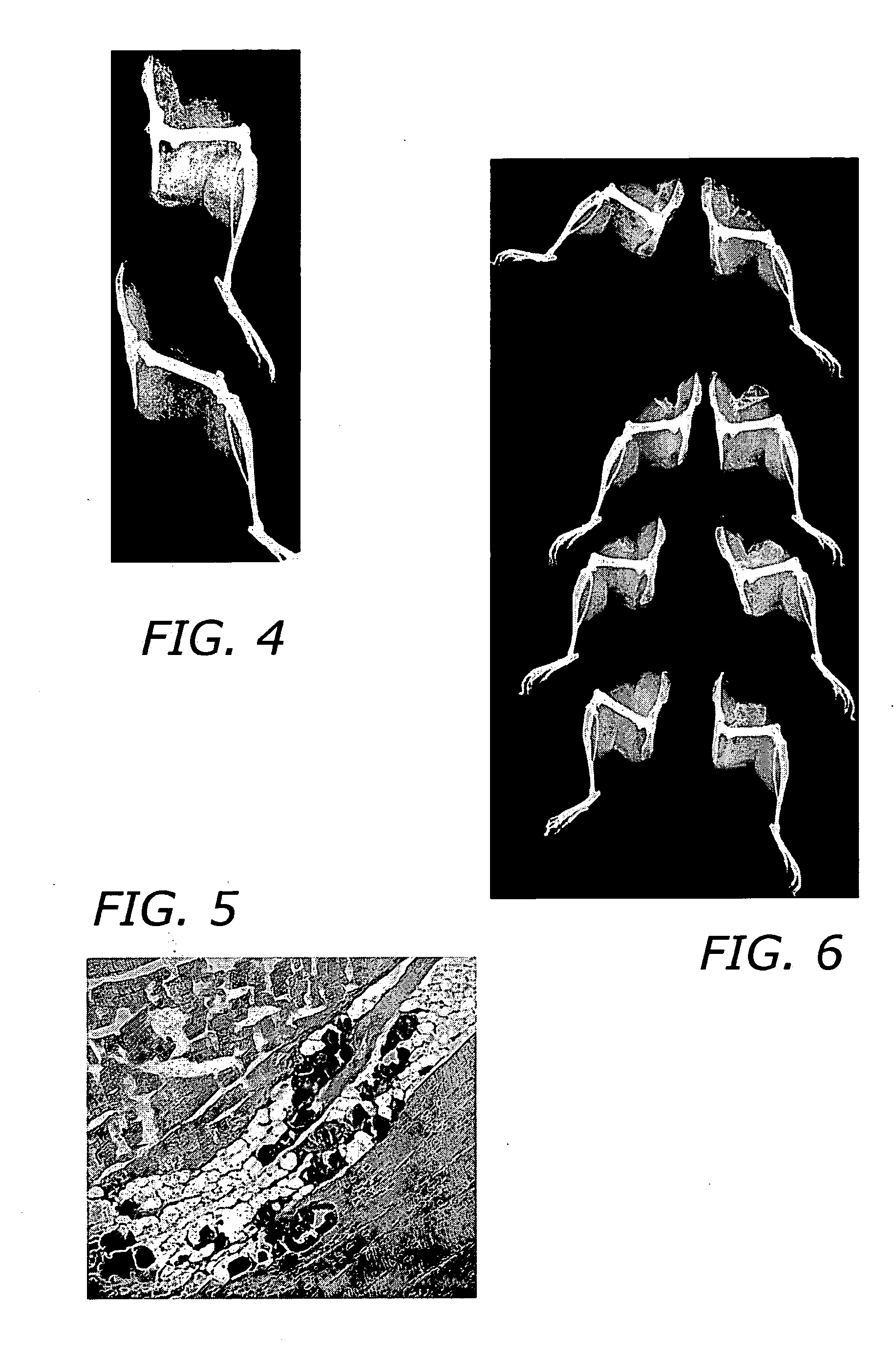Enhancement of bmp retention
a bmp and morphogenic protein technology, applied in the direction of osteogenic factor, peptide/protein ingredient, drug composition, etc., can solve the problems of significant donor-site morbidity, limited quantity and quality of autogenous bone grafts, increased operative time and blood loss, etc., to achieve early and greater mesodermal stem cell proliferation, chondrogenesis, and prolong exposure of tgf- superfamily members
- Summary
- Abstract
- Description
- Claims
- Application Information
AI Technical Summary
Benefits of technology
Problems solved by technology
Method used
Image
Examples
example 1
Extraction and Separation of Non-Collagenous Bone Proteins (NPCs)
[0087]Methods: NCPs were extracted from defatted, demineralized human cortical bone powder with 4 M GuHCl, 0.5 M CaC12, 2 mM N-ethylmalemide, 0.1 mM benzamidine HCl, and 2 mM NaN3 for 18 hr at 6° C. Residual collagen and citrate-soluble NCPs were extracted by dialysis against 250 mM citrate, pH 3.1 for 24 hours at 6° C. The residue was pelleted by centrifugation (10,000×g at 6° C. for 30 min), defatted with 1:1 (v / v) chloroform:methanol for 24 hr at 23° C., collected by filtration and dried at 22° C. The material was resuspended in 4 M GuHCl, dialyzed against 4 M GuHCl, 0.2% (v / v) Triton X-100, 100 mM Tris-HCl, pH 7.2 for 24 hr at 6° C., then dialyzed against water, and centrifuged at 10,000×g for 30 min at 6° C. The pellet was lyophilized and subsequently separated by hydroxyapatite chromatorgraphy.
[0088]Chromatography was conducted using a BioLogic chromatography workstation with a CHT-10 ceramic hydroxyapatite colum...
example 2
In Vivo Activity of BBP
[0094]Methods: The osteogenic activity of material was tested using male Swiss-Weber mice aged 8 to 10 weeks were used (Taconic Farms, Germantown, N.Y.). Prior to the assay, the BBP was solubilized and lyophilized into 2 mg of atelocollagen. The dried material was placed in a #5 gelatin capsule and sterilized by exposure to chloroform vapor. To conduct the assay, mice were anesthetized using 1% isoflurane delivered in oxygen at 2 l / min through a small animal anesthesia machine (VetEquip, Pleasanton, Calif.). Animals were affixed to a surgery board and the fur over the hindquarters shaved. The skin was cleaned with 70% ethanol and a midline incision made over the spine adjacent to the hindquarters. Blunt dissection with scissors was used to expose the quadriceps muscle on one side. A small pouch was made in the muscle using the point of scissors and the #5 capsule containing the test material was inserted into the pouch. The skin was then closed with three 11 m...
example 3
Surface Plasmon Resonance to Determine the Interaction of BMP-2 and the Synthetic Peptide
[0105]Methods: The binding interaction between rhBMP-2 and BBP was characterized using surface plasmon resonance employing a Biacom X instrument (Biacore, Piscataway, N.J.). Buffers and chips for the procedure were obtained from Biacore. RhBMP-2 was dialyzed into 10 mM sodium acetate, pH 5.5 at a concentration of 1 mg / ml. This material was then attached to a CM-5 sensor chip using reagents and procedures supplied by the manufacturer. Running buffer was 10 mM HEPES, pH 7.4, 150 mM NaCl, 3 mM EDTA, 0.005% Surfactant P20. The peptide was dissolved in running buffer at concentrations ranging from 1×10−5 to 1×10−4 M. Flow rates from 5 to 50 μl / min and injection volumes of 20 to 100 μl were employed. The regeneration solution was 10 μM glycine-HCl, pH 2.0.
[0106]Results: Results of the surface plasmon resonance studies to determine the interaction between rhBMP-2 and BBP are shown in FIG. 9.
[0107]FIG. ...
PUM
| Property | Measurement | Unit |
|---|---|---|
| Concentration | aaaaa | aaaaa |
| Equilibrium | aaaaa | aaaaa |
| Dissociation constant | aaaaa | aaaaa |
Abstract
Description
Claims
Application Information
 Login to View More
Login to View More - R&D
- Intellectual Property
- Life Sciences
- Materials
- Tech Scout
- Unparalleled Data Quality
- Higher Quality Content
- 60% Fewer Hallucinations
Browse by: Latest US Patents, China's latest patents, Technical Efficacy Thesaurus, Application Domain, Technology Topic, Popular Technical Reports.
© 2025 PatSnap. All rights reserved.Legal|Privacy policy|Modern Slavery Act Transparency Statement|Sitemap|About US| Contact US: help@patsnap.com



